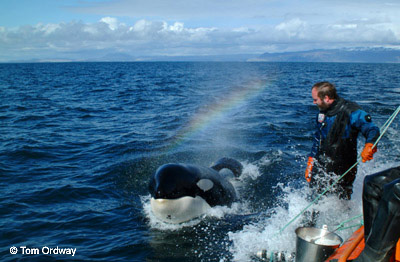The Real Story — Freeing Keiko
The first orca to be returned to the wild from captivity
The Big Business of DolphinsPart 2 of “Dolphins & Us“ The Business of Dolphins The Movie that Launched a Revolution The Real Story: Freeing Keiko Ric O’Barry: From Flipper to The Cove Tilikum: The Slave Who Fought Back Life and Death at SeaWorld The Drive Hunts Interviews & Reports “Don’t Buy a Ticket!” More about Ric O’Barry The “Spartacus” of Whales My Visit to SeaWorld A Whale of a Business The Cove NEXT: Part Three: Saving the Dolphins. See also Part One: The Smartest of Us All? |
 Keiko was about 2 years old when he was captured near Iceland in 1979 and later sold to Marineland in Canada. In 1985, Marineland sold him to a dump of an amusement park in Mexico City, called Reino Aventura, for $350,000.
Keiko was about 2 years old when he was captured near Iceland in 1979 and later sold to Marineland in Canada. In 1985, Marineland sold him to a dump of an amusement park in Mexico City, called Reino Aventura, for $350,000.
Keiko languished there for seven years until Warner Brothers made a deal with the owners to use him in a children’s movie they were planning – Free Willy.
The movie became such a hit that Warner Brothers and the amusement park quickly came under pressure to free Keiko. The Earth Island Institute took up his cause and launched the Free Keiko campaign. Warner donated $4 million to the effort, and in 1995, the amusement park handed Keiko over, without charge, to the Free Willy/Keiko Foundation.
Keiko’s return to the wild
Soon, enough funds had been raised to build a special aquarium on the Oregon coast, where Keiko could get urgent medical treatment (he was 2,000 pounds underweight) and learn how to live in the wild again. In September 1998, Keiko, now about 22 years old, was taken to the Atlantic Ocean near Iceland where he could meet up with other pods of orcas and become a wild whale himself.
Keiko then surprised his caregivers by setting off by himself on a 1,000 mile journey, ending up in a fjord in Norway, where thousands of people came to visit him. Since he’d become so used to humans through his captivity, Keiko enjoyed the company, but the Norwegian authorities were worried about crowd control, and Keiko was led to a more secluded area where he was free to come and go, and where he enjoyed another year of living in freedom until he developed a respiratory infection. On December 12, 2003, he died of pneumonia – a condition that stemmed from his years of captivity in Mexico.
Keiko’s journey to freedom inspired efforts around the world to bring an end to the business of capturing dolphins and holding them in amusement parks. Those efforts continue to this day. And among the leaders of the effort to shut down the exploitation of dolphins is a man who used to train the dolphins for the famous 1960s TV show Flipper.
